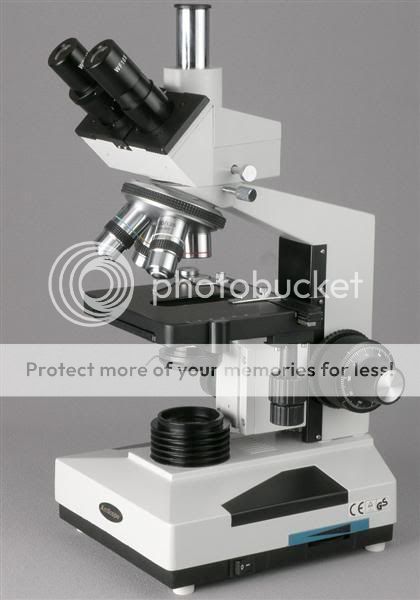Dave Weldon
Avid Member
Howdy,
The topic of microscopes can easily turn into another hobby! Yep, you guessed it, there are internet forums for microscopy hobbyists. http://tech.groups.yahoo.com/group/Microscope/ is a very busy site. Most are dedicated to using used, high quality equipment. I came very close to getting gear like that but finally decided to go with a "cheap knock-off" of the "good stuff". My 'scope is often described as a Pacific Rim product. Lots of places (mostly internet) sell these scopes that are often assembled by the same operations that assemble the high-end scopes for the big-names like Nikon and Olympus etc. The biggest difference is the quality of the optics. What I bought is obviously adequate for my present needs although I'm sure that I would enjoy the quality of a high-end laboratory grade microscope. The same optical quality and configuration of my trinocular microscope can be found new from anywhere between about $225 to $600 and up. New lab quality scopes cost many $1000's and used ones range from $100's to $1000's. You've really got to know what to look for when it comes to microscopes. Used ones can have extensive and expensive damage to the mechanics and optics. You don't need a trinocular scope to do photographs but it makes it easier than a binocular scope when it comes to putting the digital camera or USB video camera on the scope. Ok... way too much info... ... Anyway, I snagged my new scope on eBay on a very quiet Thanksgiving morning where the regular bidders were busy cooking turkeys. My winning bid was only $207 while the usual bids were more around $250-$300 and up. Tax, shipping etc. brought it to about $270. The funny thing is that the high quality DSLR camera adapter from another source cost me over $300
... Anyway, I snagged my new scope on eBay on a very quiet Thanksgiving morning where the regular bidders were busy cooking turkeys. My winning bid was only $207 while the usual bids were more around $250-$300 and up. Tax, shipping etc. brought it to about $270. The funny thing is that the high quality DSLR camera adapter from another source cost me over $300  . There are cheaper ways to adapt a camera but...
. There are cheaper ways to adapt a camera but...

By the way, 40X, 100X and 400X are the most useful magnification ranges for what I'm doing. 1000X usually requires oil emersion which is messy etc. A sharp 400X image beats a blury 1000X any day .
.
Here's what looks to be the same one that I bought. Every so often they put one up for auction with no minimum bid and that's how I got mine so cheap.
http://cgi.ebay.com/40X-1600X-DOCTO...4QQihZ007QQcategoryZ71410QQrdZ1QQcmdZViewItem
Almost forgot to mention the book in my signature!
Everyone needs to snag a copy of:
***"Understanding Reptile Parasites" By Roger J. Klingenberg D.V.M. ***
Cheap at twice the price...
The topic of microscopes can easily turn into another hobby! Yep, you guessed it, there are internet forums for microscopy hobbyists. http://tech.groups.yahoo.com/group/Microscope/ is a very busy site. Most are dedicated to using used, high quality equipment. I came very close to getting gear like that but finally decided to go with a "cheap knock-off" of the "good stuff". My 'scope is often described as a Pacific Rim product. Lots of places (mostly internet) sell these scopes that are often assembled by the same operations that assemble the high-end scopes for the big-names like Nikon and Olympus etc. The biggest difference is the quality of the optics. What I bought is obviously adequate for my present needs although I'm sure that I would enjoy the quality of a high-end laboratory grade microscope. The same optical quality and configuration of my trinocular microscope can be found new from anywhere between about $225 to $600 and up. New lab quality scopes cost many $1000's and used ones range from $100's to $1000's. You've really got to know what to look for when it comes to microscopes. Used ones can have extensive and expensive damage to the mechanics and optics. You don't need a trinocular scope to do photographs but it makes it easier than a binocular scope when it comes to putting the digital camera or USB video camera on the scope. Ok... way too much info...

By the way, 40X, 100X and 400X are the most useful magnification ranges for what I'm doing. 1000X usually requires oil emersion which is messy etc. A sharp 400X image beats a blury 1000X any day
Here's what looks to be the same one that I bought. Every so often they put one up for auction with no minimum bid and that's how I got mine so cheap.
http://cgi.ebay.com/40X-1600X-DOCTO...4QQihZ007QQcategoryZ71410QQrdZ1QQcmdZViewItem
Almost forgot to mention the book in my signature!
Everyone needs to snag a copy of:
***"Understanding Reptile Parasites" By Roger J. Klingenberg D.V.M. ***
Cheap at twice the price...
Last edited:


